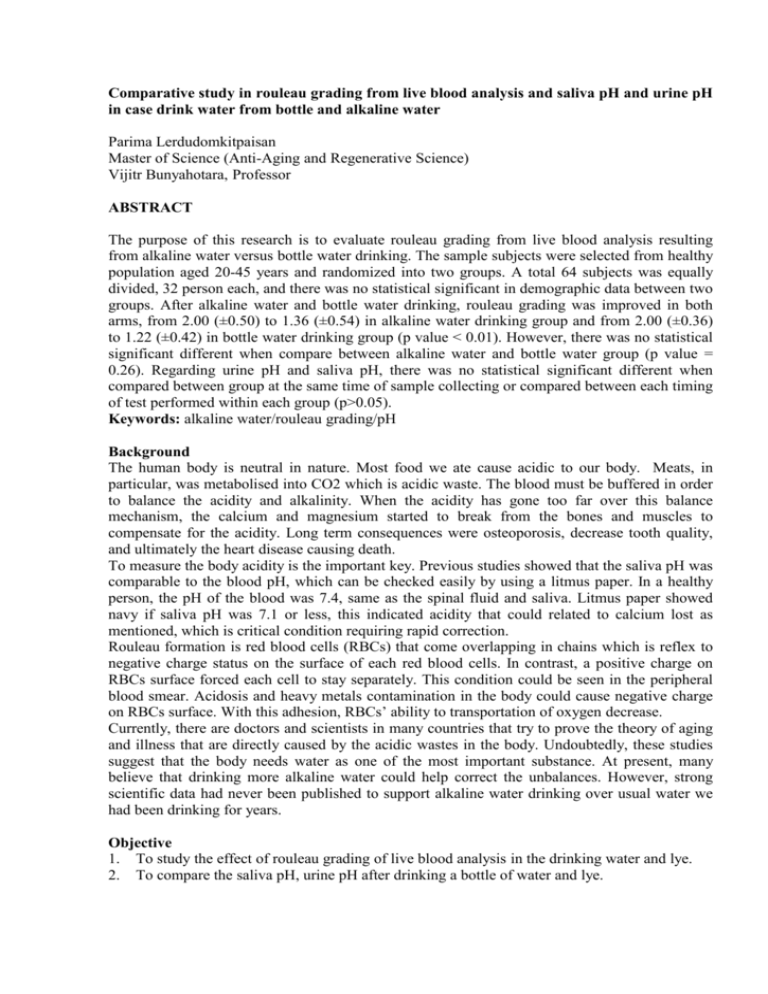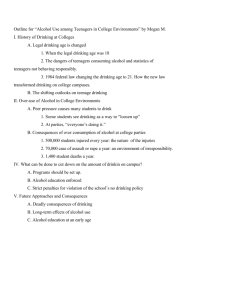Comparative study in rouleau grading from live blood analysis and
advertisement

Comparative study in rouleau grading from live blood analysis and saliva pH and urine pH in case drink water from bottle and alkaline water Parima Lerdudomkitpaisan Master of Science (Anti-Aging and Regenerative Science) Vijitr Bunyahotara, Professor ABSTRACT The purpose of this research is to evaluate rouleau grading from live blood analysis resulting from alkaline water versus bottle water drinking. The sample subjects were selected from healthy population aged 20-45 years and randomized into two groups. A total 64 subjects was equally divided, 32 person each, and there was no statistical significant in demographic data between two groups. After alkaline water and bottle water drinking, rouleau grading was improved in both arms, from 2.00 (±0.50) to 1.36 (±0.54) in alkaline water drinking group and from 2.00 (±0.36) to 1.22 (±0.42) in bottle water drinking group (p value < 0.01). However, there was no statistical significant different when compare between alkaline water and bottle water group (p value = 0.26). Regarding urine pH and saliva pH, there was no statistical significant different when compared between group at the same time of sample collecting or compared between each timing of test performed within each group (p>0.05). Keywords: alkaline water/rouleau grading/pH Background The human body is neutral in nature. Most food we ate cause acidic to our body. Meats, in particular, was metabolised into CO2 which is acidic waste. The blood must be buffered in order to balance the acidity and alkalinity. When the acidity has gone too far over this balance mechanism, the calcium and magnesium started to break from the bones and muscles to compensate for the acidity. Long term consequences were osteoporosis, decrease tooth quality, and ultimately the heart disease causing death. To measure the body acidity is the important key. Previous studies showed that the saliva pH was comparable to the blood pH, which can be checked easily by using a litmus paper. In a healthy person, the pH of the blood was 7.4, same as the spinal fluid and saliva. Litmus paper showed navy if saliva pH was 7.1 or less, this indicated acidity that could related to calcium lost as mentioned, which is critical condition requiring rapid correction. Rouleau formation is red blood cells (RBCs) that come overlapping in chains which is reflex to negative charge status on the surface of each red blood cells. In contrast, a positive charge on RBCs surface forced each cell to stay separately. This condition could be seen in the peripheral blood smear. Acidosis and heavy metals contamination in the body could cause negative charge on RBCs surface. With this adhesion, RBCs‘ ability to transportation of oxygen decrease. Currently, there are doctors and scientists in many countries that try to prove the theory of aging and illness that are directly caused by the acidic wastes in the body. Undoubtedly, these studies suggest that the body needs water as one of the most important substance. At present, many believe that drinking more alkaline water could help correct the unbalances. However, strong scientific data had never been published to support alkaline water drinking over usual water we had been drinking for years. Objective 1. To study the effect of rouleau grading of live blood analysis in the drinking water and lye. 2. To compare the saliva pH, urine pH after drinking a bottle of water and lye. Methodology Research procedures 1. Selected female and male volunteers aged 20-45 years who received services at the Villa Medica. 2. Call for volunteers from groups that are eligible under the terms and conditions of the initial 64 patients. History, general health information Including history, drug allergies and medical conditions. Is there a case for non-compliant diabetic kidney disease, heart disease, high blood pressure, bleeding problems and those are hard to get out. 3. Volunteers Objectives have been How to Conduct Details of each and benefits to be Side effects that may result from the research literature. Then the patient's signed consent to treatment. 4. Examination Assessment of vital signs 5. Divided volunteers into two groups using random Divided into two groups (Group drinking crystal) and the experimental group. This group is to drink alkaline water2 groups of volunteers. 6. Volunteers performing live blood analysis and saliva pH, urine pH recorded baseline values prior to trial. 7. Volunteers drinking water is clear water bottle with two empty bottles of drinking water, including crystal. And a bottle of lye the participants will be in the water without knowing anything. This identifies it as code by taking a bottle of water each code selected at random. 8. The control group will receive a Crystal. The experimental group received lye. 9. Subject to drink water of the 2 groups at 0, 1, 2, 3 hours per 250 cc. 10. All 4 glasses of water did the research will be the live blood analysis and saliva pH, urine pH again. 11. Measure saliva pH, urine pH 8:00a.m. 12. Side effects and blood pressure of the participants during the research. Result Table 4.2 Rouleau formation grading, the pH of saliva and urine at various times after drinking comparing between drinking bottled water drinking alkaline water. Alkaline water Bottle water Stat P value Rouleau grading: After a 1.36 (±0.54) drink 1.22 (±0.42) 0.26 Saliva pH: After a drink 6.015 (±0.08) 6.048 (±0.15) 0.27 Saliva pH: Next morning 6.030 (±0.12) 6.048 (±0.15) Urine pH: After a drink 7.045 (±0.14) 7.046 (±0.15) 0.93 Urine pH: Next morning 7.015 (±0.08) 7.016 (±0.08) 0.96 t-test 0.59 Table 4.2 showed that rouleau grading had no statistical significant difference between two groups (p value = 0.26). The average grading and standard deviation was 1.36 ± 0.54 and 1.22 ± 0.15 points in alkaline and bottled water drinking group, respectively. The comparison of saliva pH after drinking and the next morning between two groups found no statistically significant difference, as well as urine pH (p > 0.05). Comparing within each group between base line rouleau grading and after drinking water, we found that score was better for both groups. Rouleau formation grading value (Table 4.3) improve from the mean and standard deviation of 2.00 ± 0.50 to 1.36 ± 0.54 (p <0.01) and from 2.00 ± 0.36 to 1.22 ± 0.15 in the alkaline water drinking group and bottled water drinking group, respectively. Conversely, when compared saliva pH or urine pH within each group at each time of sample collecting, there was no statistical significant difference. (Table 4.4 and 4.5) Table 4.3 Compare rouleau grading before and after drinking alkaline water and bottled water. Baseline Rouleau grading Rouleau grading a drink 2.00 1.36 < 0.01 Drinking 2.00 bottled water 1.22 < 0.01 Drinking alkaline water After P value Table 4.4 Compare Saliva pH before, and the next morning after drinking one in the group drinking alkaline water and drink bottled water. Saliva Baselin pH P e saliva After a value pH drink Baseli ne saliva pH Saliva pH Next Day Saliva Saliva P pH pH value After a Next drink Day P value Drinking alkaline water 6.015 6.015 1.00 6.015 6.030 0.65 6.015 6.030 0.56 Drinking bottled water 6.048 6.048 1.00 6.048 6.048 1.00 6.048 6.048 1.00 Table 4.5 Compare Urine pH before, and the next morning after drinking one in the group drinking alkaline water and drink bottled water. Urine Baselin pH P e urine After a value pH drink Baseli Urine ne pH urine Next pH Day Urine Urine P pH pH value After a Next drink Day P value Drinking alkaline water 7.000 7.045 0.17 7.000 7.015 0.56 7.045 7.015 0.39 Drinking bottled water 6.983 7.046 0.09 6.983 7.016 0.16 7.048 7.016 0.30 In this randomised controlled-clinical trial. The two experimental groups, the alkaline water and bottled water, had better rouleau formation grading after drinking water as showed above (from the average 2.0 ± 0.5 to 1.36 ± 0.54 in the alkaline water drinking group and from 2.0 ± 0.36 to 1.22 ± 0.42 in bottle water drinking group). This is a significantly better scores (P < 0.05). However, this score was not statistically differ when compared between two groups (p = 0.26). The rouleau formation grading by peripheral blood smear is a subjective evaluation methods which may contain bias and measurement error. However, at present there is no accurate way to assess rouleau grading apart from this method. Most of participants enrolled had relatively acidic rouleau score (mean 2.0 ± 0.44 points), this indicated acidic status in the general population. Acidic improvement using rouleau grading as measurement was achieved either with bottled water drinking or alkaline water drinking. It might be concluded that it was not the pH of the water that cause a better in grading, but the other factor is a major role of grading improvement, such as drinking water, which is same in both experimental groups. Acidity measured by rouleau grading was differ from actual pH derived from urine and saliva. Base line pH in urine and saliva was 6.015 (± 0.15) and 6.048 (± 0.15), respectively, which were within normal range. Also, There were normal with no statistical significant difference when tested after drinking water and the next morning (p> 0.05). Saliva pH showed that the body can remain in normal pH after 1 litre of 8.5 pH water drinking. The urine pH, which was normal, stated that this amount of 8.5 pH water cannot interfere with pH balance system of the body. Rouleau formation depends on many factors that had not been studied in this trial. We can at least concluded that the rouleau formation might not be a good indicator for body pH as it was differ from urine and saliva pH. However, drinking 1 litre of any alkaline or bottle water can help improve rouleau grading of the RBCs in our circulation. Conclusion In theory, drinking alkaline water could alkalinised the acidic from the daily routine of humans in modern times. In the past experiments, there is no clear benefit of alkaline water consumption. And especially in a nearly 600 pages Guideline for Drinking-water Quality by World Health Organization (WHO), did not event mention regarding pH of good water. In this study, the conclusion is that drinking bottled water and drinking alkaline water (1 liter of 8.5 pH water) can equal improve RBCs rouleau score, significantly. However, there was no difference between bottled water and alkaline water in changing urine and saliva pH in a normal pH condition of the body. Suggestions 1. Study factors effecting the rouleau grading addition to drinking alkaline water. 2. Study in populations with acidity as baseline. 3. The more precise method of measuring the acidity. 4. Increase follow up time. References






